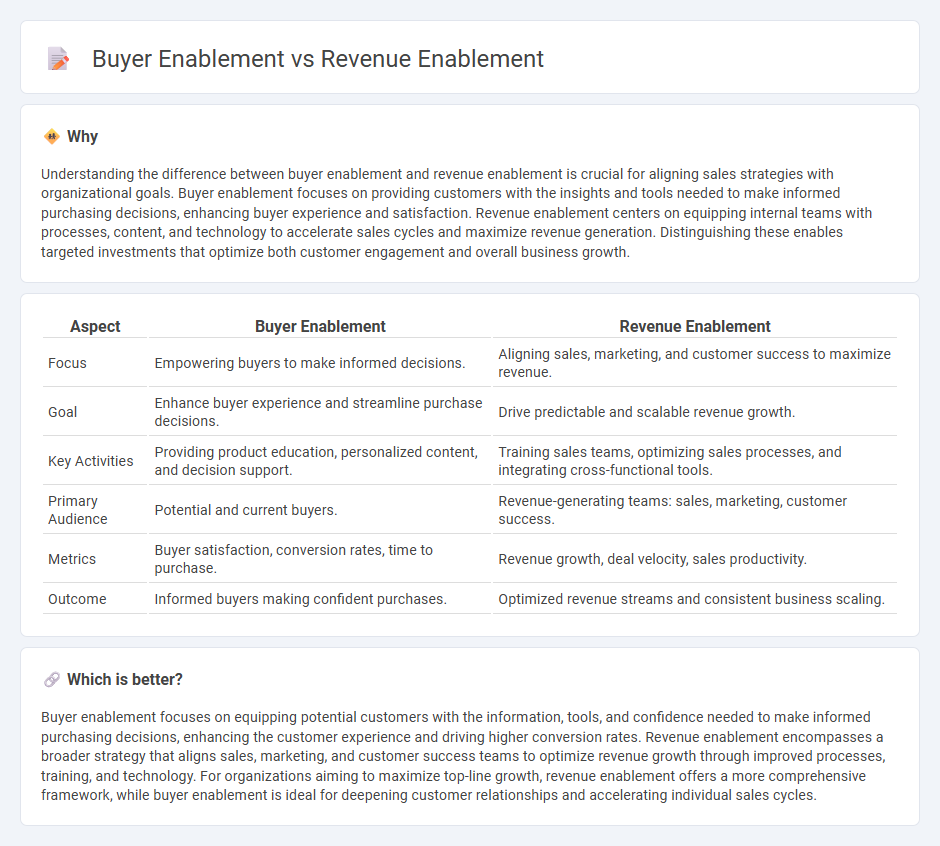
Buyer enablement focuses on providing customers with the tools, information, and resources necessary to facilitate informed purchasing decisions, improving the overall buyer experience. Revenue enablement, on the other hand, aligns sales, marketing, and customer success teams with strategies and processes designed to accelerate revenue growth and optimize sales performance. Explore how integrating buyer and revenue enablement can drive more effective sales outcomes and business growth.
Why it is important
Understanding the difference between buyer enablement and revenue enablement is crucial for aligning sales strategies with organizational goals. Buyer enablement focuses on providing customers with the insights and tools needed to make informed purchasing decisions, enhancing buyer experience and satisfaction. Revenue enablement centers on equipping internal teams with processes, content, and technology to accelerate sales cycles and maximize revenue generation. Distinguishing these enables targeted investments that optimize both customer engagement and overall business growth.
Comparison Table
| Aspect | Buyer Enablement | Revenue Enablement |
|---|---|---|
| Focus | Empowering buyers to make informed decisions. | Aligning sales, marketing, and customer success to maximize revenue. |
| Goal | Enhance buyer experience and streamline purchase decisions. | Drive predictable and scalable revenue growth. |
| Key Activities | Providing product education, personalized content, and decision support. | Training sales teams, optimizing sales processes, and integrating cross-functional tools. |
| Primary Audience | Potential and current buyers. | Revenue-generating teams: sales, marketing, customer success. |
| Metrics | Buyer satisfaction, conversion rates, time to purchase. | Revenue growth, deal velocity, sales productivity. |
| Outcome | Informed buyers making confident purchases. | Optimized revenue streams and consistent business scaling. |
Which is better?
Buyer enablement focuses on equipping potential customers with the information, tools, and confidence needed to make informed purchasing decisions, enhancing the customer experience and driving higher conversion rates. Revenue enablement encompasses a broader strategy that aligns sales, marketing, and customer success teams to optimize revenue growth through improved processes, training, and technology. For organizations aiming to maximize top-line growth, revenue enablement offers a more comprehensive framework, while buyer enablement is ideal for deepening customer relationships and accelerating individual sales cycles.
Connection
Buyer enablement focuses on providing customers with the resources and information needed to make informed purchasing decisions, while revenue enablement aligns sales, marketing, and customer success teams to optimize revenue generation. Both strategies interconnect by enhancing the buyer's journey through targeted content and personalized engagement, ultimately driving higher conversion rates and consistent revenue growth. Integrating buyer enablement tools within revenue enablement frameworks ensures seamless communication and improved sales effectiveness.
Key Terms
**Revenue Enablement:**
Revenue enablement concentrates on empowering sales, marketing, and customer success teams with tools, content, and training to drive predictable revenue growth and optimize the buyer journey. It aligns cross-functional strategies to ensure consistent messaging and effective engagement throughout the sales funnel, enhancing conversion rates and pipeline velocity. Explore how revenue enablement can transform your business outcomes and accelerate revenue generation.
Sales Process Optimization
Revenue enablement centers on aligning marketing, sales, and customer success teams to optimize the entire sales process, driving consistent revenue growth by delivering relevant content and tools at every stage. Buyer enablement focuses on providing prospects with the information and resources needed to make informed purchasing decisions, thereby accelerating deal cycles and improving buyer satisfaction. Explore in-depth strategies to enhance both revenue and buyer enablement for a streamlined sales process optimization.
Cross-Functional Alignment
Revenue enablement emphasizes aligning sales, marketing, and customer success teams to drive consistent revenue growth and optimize the entire customer lifecycle. Buyer enablement focuses on providing prospects with relevant information and tools at each stage of their purchasing journey to facilitate informed decision-making. Explore strategies for integrating revenue and buyer enablement to achieve seamless cross-functional alignment and improved business outcomes.
Source and External Links
What is Revenue Enablement? - Mediafly - Revenue enablement increases revenue teams' productivity and effectiveness by aligning sales, marketing, and customer success to shared goals, providing insights, tools, and training to engage the right buyers at the right time and optimize the buyer journey.
What is Revenue Enablement? | Mindtickle - Revenue enablement expands on sales enablement by aligning all customer-facing teams around common revenue goals, optimizing the customer journey, implementing supportive technology stacks, and continuously measuring and refining performance.
What is Revenue Enablement? (An Enabler's Guide) - Revenue enablement is a strategic function that supports all revenue-generating teams--including sales, marketing, customer success, and product--with resources, tools, and training to perform effectively throughout the entire customer journey, focusing on buyer experience rather than just sales.
 dowidth.com
dowidth.com